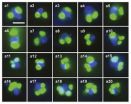(Press-News.org) WASHINGTON, Jan. 20 – The eyes of moths, which allow them to see well at night, are also covered with a water-repellent, antireflective coating that makes their eyes among the least reflective surfaces in nature and helps them hide from predators in the dark. Mimicking the moth eye's microstructure, a team of researchers in Japan has created a new film, suitable for mass-production, for covering solar cells that can cut down on the amount of reflected light and help capture more power from the sun.
In a paper appearing in Energy Express (www.OpticsInfoBase.org/ee), a bi-monthly supplement to Optics Express, the open-access journal published by the Optical Society (OSA), the team describes how this film improves the performance of photovoltaic modules in laboratory and field experiments, and they calculate how the anti-reflection film would improve the yearly performance of solar cells deployed over large areas in either Tokyo, Japan or Phoenix, Ariz.
"Surface reflections are an essential loss for any type of photovoltaic module, and ultimately low reflections are desired," says Noboru Yamada, a scientist at Nagaoka University of Technology Japan, who led the research with colleagues at Mitsubishi Rayon Co. Ltd. and Tokyo Metropolitan University.
The team chose to look at the effect of deploying this antireflective moth-eye film on solar cells in Phoenix and Tokyo because Phoenix is a "sunbelt" city, with high annual amount of direct sunlight, while Tokyo is well outside the sunbelt region with a high fraction of diffuse solar radiation.
They estimate that the films would improve the annual efficiency of solar cells by 6 percent in Phoenix and by 5 percent in Tokyo.
"People may think this improvement is very small, but the efficiency of photovoltaics is just like fuel consumption rates of road vehicles," says Yamada. "Every little bit helps."
Yamada and his colleagues found the inspiration for this new technology a few years ago after they began looking for a broad-wavelength and omnidirectional antireflective structure in nature. The eyes of the moth were the best they found.
The difficulty in making the film, says Yamada, was designing a seamless, high-throughput roll-to-roll process for nanoimprinting the film. This was ultimately solved by Hideki Masuda, one of the authors on the Energy Express paper, and his colleagues at Mitsubishi Rayon Co. Ltd.
The team is now working on improving the durability of the film and optimizing it for many different types of solar cells. They also believe the film could be applied as an anti-reflection coating to windows and computer displays.
###
Paper: "Characterization of antireflection moth-eye film on crystalline silicon photovoltaic module," Noboru Yamada, Toshikazu Ijiro, Eiko Okamoto, Kentaro Hayashi, and Hideki Masuda, Optics Express, Vol. 19, Issue S2, pp. A118-A125. Available at: http://www.opticsinfobase.org/oe/abstract.cfm?uri=oe-19-102-A118.
EDITOR'S NOTE: A hi-resolution image of several rolls of this antireflective film is available for use by journalists. Please contact astark@osa.org.
About OSA
Uniting more than 106,000 professionals from 134 countries, the Optical Society (OSA) brings together the global optics community through its programs and initiatives. Since 1916 OSA has worked to advance the common interests of the field, providing educational resources to the scientists, engineers and business leaders who work in the field by promoting the science of light and the advanced technologies made possible by optics and photonics. OSA publications, events, technical groups and programs foster optics knowledge and scientific collaboration among all those with an interest in optics and photonics. For more information, visit http://www.osa.org.
END
VIDEO:
A two-minute video, "Morphological Change in Machines Accelerates the Evolution of Robust Behavior, " was produced by the Morphology, Evolution and Cognition Laboratory, University of Vermont, 2011.
Click here for more information.
Want to build a really tough robot? Forget about Terminator. Instead, watch a tadpole turn into a frog.
Or at least that's not too far off from what University of Vermont roboticist Josh Bongard has discovered, as he reports ...
AURORA, Colo. (Jan. 20, 2011)--Cancer scientists have designed the first molecular test to predict which bladder cancer patients may have cancer involvement in their lymph nodes at the time of surgery—which could help doctors determine which patients are good candidates for pre-surgical, or neo-adjuvant, chemotherapy.
The test analyzes 20 genes on tumor biopsies, according to a paper published online Jan. 20, 2011, in Lancet Oncology.
"Randomized clinical trials have shown that giving neo-adjuvant chemotherapy extends patient lives, but only 5 to 15 percent of patients ...
In a paper published today in the journal Science, a University of California, Davis, researcher and his co-authors challenge a widely held assumption that plants will move uphill in response to warmer temperatures.
Between 1930 and 2000, instead of colonizing higher elevations to maintain a constant temperature, many California plant species instead moved downhill an average of 260 feet, said Jonathan Greenberg, an assistant project scientist at the UC Davis Center for Spatial Technologies and Remote Sensing.
"While the climate warmed significantly in this period, ...
With little more than a conventional photocopier and transparency film, anyone can build a functional microfluidic chip.
A local Cambridge high school physics teacher invented the process; now, thanks to a new undergraduate teaching lab at Harvard's School of Engineering and Applied Sciences (SEAS), students will be able explore microfluidics and its applications.
The Microfluidics Lab, developed by Dr. Anas Chalah, Director of Instructional Technology at SEAS, takes advantage of a simple but ingenious new method of creating lab-on-a-chip devices that are quick to produce, ...
DETROIT—Wayne State University researchers have found that when patients and providers speak the same language, patients report less confusion and better health care quality. The findings were based on data from the Pew Hispanic Center/Robert Wood Johnson Foundation's Latino Health Survey.
Understanding the relationship between language and health care quality has important public health implications for providing services in an increasingly diverse U.S. population, according to Hector M. González, Ph.D., assistant professor of family medicine and public health at WSU's ...
Breast cancer patients who have a strong social support system in the first year after diagnosis are less likely to die or have a recurrence of cancer, according to new research from Vanderbilt-Ingram Cancer Center (VICC) and the Shanghai Institute of Preventive Medicine. The study, led by first author Meira Epplein, Ph.D., assistant professor of Medicine at VICC, was published in a recent edition of the Journal of Clinical Oncology.
Patients in the study were enrolled in the Shanghai Breast Cancer Survivor Study, a large, population-based review of female breast cancer ...
A team of biologists has discovered an entirely new group of algae living in a variety of marine and freshwater environments. This group of algae, which the researchers dubbed "rappemonads," have DNA that is distinctly different from that of other known algae. In fact, humans and mushrooms are more closely related to each other than rappemonads are to some other common algae (such as green algae). Based on their DNA analysis, the researchers believe that they have discovered not just a new species or genus, but a potentially large and novel group of microorganisms.
The ...
New research reveals that a hormone best known for stimulating the production of red blood cells can modulate the immune response. The study, published by Cell Press in the January 27th issue of the journal Immunity, finds that erythropoietin (EPO) has contrasting influences on infectious and inflammatory diseases and may be useful in the design of new therapeutic strategies.
EPO is a cytokine hormone that stimulates the production of red blood cells by acting at EPO receptors (EPORs) on red blood cell precursors. Interestingly, other cell types also express EPORs. ...
LOUISVILLE, Ky. – Healthcare workers can most directly affect quality of life (QOL) of patients with advanced stage lung cancer by helping manage symptoms such as pain, lack of energy, shortness of breath, coughing, difficulty sleeping and dry mouth, according to a study recently published in the journal Oncology Nursing Forum.
Understanding the symptoms, particularly symptom distress - or the degree to which a symptom bothers a person, is crucial to improved patient care. Intervention at the time of diagnosis is important because patients with stage IIIb or IV lung cancer ...
The difficult task of sorting and counting prized stem cells and their cancer-causing cousins has long frustrated scientists looking for new ways to help people who have progressive diseases.
But in a development likely to delight math teachers, University of Florida researchers have devised a series of mathematical steps that accomplishes what the most powerful microscopes, high-throughput screening systems and protein assays have failed to do — assess how rapidly stem cells and their malignant, stemlike alter egos increase their numbers.
The method, published in the ...



